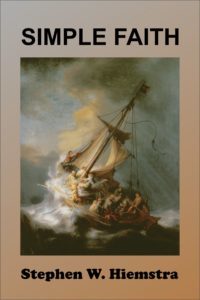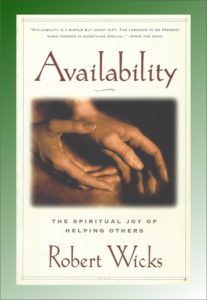Stephen W. Hiemstra's Blog, page 208
May 13, 2018
Mother’s Day Prayer 2018
 Mom and I, 1954
Mom and I, 1954Heavenly Father,
Thank you for my mother
who brought me into this world, raised and encouraged me.
Thank you for your ongoing presence and encouragement.
Be especially present in her life today.
Though many years have passed between us,
may each and every day be a blessing.
In the power of your Holy Spirit,
may she continue to walk with you
and serve you as well as she has served me.
In Jesus’ precious name, Amen.
Mother’s Day Prayer 2018
Also see:
Giving Thanks
A Place for Authoritative Prayer
Other ways to engage online:
Author site: http://www.StephenWHiemstra.net, Publisher site: http://www.T2Pneuma.com.
Newsletter at: http://bit.ly/2018_Ascension
The post Mother’s Day Prayer 2018 appeared first on T2Pneuma.net.
May 11, 2018
Limits to a Cognitive Approach
 By Stephen W. Hiemstra
By Stephen W. Hiemstra
Epistemology takes seriously the question of how we know what we know and the field of inquiry assumes a cognitive approach to learning. The presumption is that human being are essentially rational and that faith itself is a rational undertaking. The Bible suggests, however, that this cognitive approach has two important limitations when we discuss faith.
Creation Influences Thought
The first limitation arises because we are created, male and female, in the image of of a triune God. Being created to live and reproduce in families implies that we experience the world in community. Much as we want our independence, our thoughts, feelings, and language are not entirely our own.
Even more so, being created in the image of a triune God differs from being created in the image of a unitary god. The Bible portrays God as Father, Son, and Holy Spirit—a complete community in the godhead, as Jesus references after the Last Super:
“But when the Helper comes, whom I will send to you from the Father, the Spirit of truth, who proceeds from the Father, he will bear witness about me.” (John 15:26 ESV)
In imaging a triune God, we image a community, something we can neither fully embody nor understand. Unlike a unitary god, which is fixed, stable, and offers mostly an opportunity for self-projection, a triune God is dynamic, alive, and changing.
In particular, the language we speak shapes our perceptions of reality in fundamental ways, not the least of which is that it reflects the culture we live and worship in. Our attitudes about gender, work, faith, and many other things are embedded in the words that we use and do not use. We are not alone in this world even in our own thoughts and feelings—we carry our community with us wherever we go. This is, in part, why words can never fully reflect our actual thoughts or feelings.
The Hebrew Heart
The wholly confusion that dominates the church today is rooted the Greek dualism that pervades western thought. While Greeks distinguished mind and body, Hebrews did not. The Hebrew mindset saw mind and body as different parts of a unified whole, whose center is the heart (cardia). Stroking emotions and teaching the head neglect the heart that responds principally to ritual. Neglected hearts see no reason to become disciples or attend church. The church then finds itself full of confused thinkers and traumatized emoters who ridicule and neglect ritual leading to even more neglected hearts. Wholly confusion naturally leads then to holy confusion.
This confusion of where our faith resides, in our hearts not our minds or emotions, implies that the cognitive approach cannot fully inform our faith. As theologian James K.A. Smith writes:
“Jesus is a teacher who doesn’t inform our intellect but forms our very loves…His ‘teaching’ doesn’t just touch the calm, cool, collected space of reflection and contemplation, he is a teacher who invades the heated, passionate regions of the heart. He is the Word who ‘penetrates even dividing the soul and spirit’; he ‘judges the thoughts and attitudes of the heart’ (Heb 4:12)” (1)
Inherent in this statement is the Hebrew view of anthropology cited above—note the two references to heart. What Greek would talk about “the thoughts and attitudes of the heart”? Drawing attention to this anthropology, Smith asks: “Do you ever experience a gap between what you know and what you do?” (5) If he had the rational mind in view, no such gap would exist but, of course, we all experience this gap.
This line of thought leads Smith to observe: “What if you are defined not by what you know [the mind] but by what you desire? [the heart] (7) If our desires are reflected more in our actions than in our words, then this Hebrew anthropology leads us immediately into an inconvenient discussion of ethics because our hearts are not lily-white clean as our words. It also forces us to discuss how we know what we know (the epistemology question) because our hearts are not so easily persuaded to follow even our own thoughts. Suddenly, much of the New Testament language sounds less churchy and more informed by an alternative world view, one decidedly not Greek and unfamiliar in American culture.
The Cognitive Theory of Emotions
In his work on emotions in the New Testament, Matthew Elliott (2006, 46-47) outlines a cognitive theory of emotions that “reason and emotion are interdependent.” The alternative is to argue that reason and emotion are independent of one another, a key assumption of the therapeutic gospel because emotions are believed to rule our lives. Elliott notes that the God of the Bible only gets angry on rare occasions and his anger (or wrath) is focused on examples of when people have disobeyed the covenant or expressed a hardness of the heart, as in the case of Pharaoh (Exod 4:21).
Clearly, we cannot talk about thinking independent of feelings and we cannot think entirely independent of the communities that we reside and worship in. We need to proceed to treat them as interdependent, complicated as that might be. Still, as best we can, we need to understand better how we know what we know before we can even talk about our faith.
References
Elliott, Matthew A. 2006. Faithful Feelings: Rethinking Emotion in the New Testament. Grand Rapids: Kregel Academic and Professional.
Smith, James K. A. 2016. You Are What You Love: The Spiritual Power of Habit. Grand Rapids: Brazos Press.
Limits to a Cognitive Approach
Also see:
A Roadmap of Simple Faith
Christian Spirituality
Looking Back
A Place for Authoritative Prayer
Other ways to engage online:
Author site: http://www.StephenWHiemstra.net, Publisher site: http://www.T2Pneuma.com.
Newsletter at: http://bit.ly/2018_Ascension
The post Limits to a Cognitive Approach appeared first on T2Pneuma.net.
May 8, 2018
Wicks Seeks Availability Deepens Faith
 Robert Wicks. 2000. Availability: The Spiritual Joy of Helping Others. New York: Crossroad Publishing Company.
Robert Wicks. 2000. Availability: The Spiritual Joy of Helping Others. New York: Crossroad Publishing Company.
Review by Stephen W. Hiemstra
One of the more interesting definitions of the soul is that it encompasses who we are and who we are in relationship with, including God. This definition differs significantly from the Greek division of the person into body and spirit or, body, mind, and spirit. It also differs from the Freudian division into id, ego, and superego. When we talk about the three movements of the spirit, popularized recently by Henri Nouwen (1975), into polarities within, with God, and with others, we converge on this ancient notion of soul. Loneliness can accordingly be accurately described as an affliction of the soul, while frankly psychologists have really no conceptual basis for even describing it because it is relational, not part of the person.
Introduction
In his book, Availability: The Spiritual Joy of Helping Others, Robert Wicks describes his book’s theme in these words:
“…the more we can remove the blocks to an appreciation of who we are and who we are becoming, the truer we can be in our response to the Gospel call to serve others and God. We must be available then to ourselves so that our relationships can flow out of a healthy attitude and a clear awareness of our motivations.”(3)
While Wicks cites many passages of scripture, the one that comes to mind for me in reflecting on this book, the story of Bartimaeus, he does not cite. It reads:
“And they came to Jericho. And as he was leaving Jericho with his disciples and a great crowd, Bartimaeus, a blind beggar, the son of Timaeus, was sitting by the roadside … And Jesus stopped and said, Call him … And Jesus said to him, What do you want me to do for you?”(Mark 10:46-52 ESV)
What celebrity stops for a random person in a crowd, one of the invisible people? Yet, time and time again, Jesus made himself radically available to strangers.
Being Available to Ourselves
If loneliness is an affliction of the soul, availability enlarges and heals the soul; it is a gift (1). Wicks writes:
“Availability to ourselves increases along with availability to God and others because there is a unity in being true to oneself, others, and God.”(39)
Wicks clearly believes that being available to ourselves is the key to unlocking this gift. Note that in writing his book in eight chapters, four are devoted to being available to ourselves (half the book) while only two chapters are devoted to being available to others and two to God (v).
Wicks focuses on being available to ourselves in terms of recognizing our uniqueness and limits, being willing to forgive ourselves in failure, cultivating self-awareness, and developing emotional and mental clarity, avoiding defensiveness.
Being Available to Others
Being available to others can be easily described, but it is an area fraught with confusion. Wicks writes:
“Being available to others is not just giving time, money, and effort. It is also not endlessly worrying about others so that our personal tension rises to the point that we are overloaded and have no energy to care about anything or anyone anymore.” (40)
Obviously, burnout is a real possibility. I have seen pastors experiencing anxiety attacks, running around trying to do everything, and being subject to temptations that would not normally afflict them, had they honored their own limits.
Being Available to God
In his discussion of being available to God, Wicks makes an important observation:
“When we play at prayer, rather than open ourselves up to listen, it is we who are truly not available to God.”(95)
When you pray, do you do all the talking? God answers prayer, sometimes quite quickly, but we need to be listening. He goes on:
“…if there is a key to understanding the problems of availability and appreciating it as a gift, this key is contained in our seeking unity within and without by placing ourselves continually in the presence of God: to relax, to sit, to learn, to work, to contemplate, to do everything in the presences of God.”(102)
When I am restless or distracted in prayer, I find it helpful to pray a centering prayer. For me, Psalm 8 centers me and helps me to separate myself from my own busyness. My own restlessness often makes continuous prayer during the day hard.
Assessment
Robert Wicks’ Availability: The Spiritual Joy of Helping Othersis short and easily read—a seminarian’s delight. Its brevity is disarming and masks the profound influence that this book had on my thinking early in seminary. After reading Wicks, I meditated on the story of Bartimaeus and Psalm 8 for years. Perhaps, you will too.
References
Nouwen, Henri J. M. 1975. Reaching Out: The Three Movements of the Spiritual Life. New York: DoubleDay. (Review)
Wicks Seeks Availability Deepens Faith
Also see:
Nouwen: Make Space for Self, Others, and God
Vanhoozer: How Do We Understand the Bible? Part 1
Books, Films, and Ministry
Other ways to engage online:
Author site: http://www.StephenWHiemstra.net, Publisher site: http://www.T2Pneuma.com.
Newsletter at: http://bit.ly/2018_Ascension
The post Wicks Seeks Availability Deepens Faith appeared first on T2Pneuma.net.
May 7, 2018
Monday Monologue, Authenticity, May 7, 2018 (Podcast)
 Stephen W. Hiemstra, 2017
Stephen W. Hiemstra, 2017By Stephen W. Hiemstra
In today’s podcast, I share a prayer of lament and a reflection on authenticity.
To listen, click on the link below.
After listening, please click here to take a brief listener survey (10 questions).
http://t2pneuma.net/wp-content/uploads/2018/04/Monday_monologue_Authenticity_20180507.mp3
Monday Monologue, Authenticity, May 7, 2018 (Podcast)
Also see:
Monday Monologue On March 26, 2018
Other ways to engage online:
Author site: http://www.StephenWHiemstra.net, Publisher site: http://www.T2Pneuma.com.
Newsletter at: http://bit.ly/2018_Ascension
The post Monday Monologue, Authenticity, May 7, 2018 (Podcast) appeared first on T2Pneuma.net.
May 6, 2018
Covering Prayer
 By Stephen W. Hiemstra
By Stephen W. Hiemstra
Merciful father,
Cover me, Lord, with your mercy
like a morning blanket when I am not ready to face the day.
Coffee offers no temptation; the sun’s glare seems yet so distant.
I want to be someone else, somewhere else in some other time.
For my life has too many moving parts
and I feel like scraps of meat being fed into the grinder.
Where has my strength gone?
The tooth paste is out of the tube and its just a mess–no teeth seem any cleaner.
Yet, you, oh Lord, are my hope.
Your story, like so many I have already experienced, has a happy ending.
The grinder does not win; coffee is not my strength; signs do not scare ghosts.
In the power of your Holy Spirit, draw me especially close today
and grant me the peace that passes all understanding,
In Jesus’ precious name, Amen.
Covering Prayer
Also see:
Giving Thanks
A Place for Authoritative Prayer
Other ways to engage online:
Author site: http://www.StephenWHiemstra.net, Publisher site: http://www.T2Pneuma.com.
Newsletter at: http://bit.ly/2018_Ascension
The post Covering Prayer appeared first on T2Pneuma.net.
May 4, 2018
Authenticity
 By Stephen W. Hiemstra
By Stephen W. Hiemstra
What exactly is beauty and why do we care?
Recently my kids took me to see a film. In it, one of Hollywood’s most beautiful actresses portrayed a low-class, manipulative, rather loose woman. The film’s plot seemed shallow and pornographic, designed more to offend than to enlighten. I left the theater upset and annoyed, not entirely understanding why.
In his book, Visual Faith, William Dyrness (2001, 81) writes:
“Our modern images feature surface and finish; Old Testament images present structure and character. Modern images are narrow and restrictive; theirs were broad and inclusive…For us beauty is primarily visual; their idea of beauty included sensations of light, color, sound, smell, and even taste” .
As the old adage goes, beauty is more than skin deep. When it is only skin deep, we take offense as I did during my recent trip to the theatre.
Beauty More than Skin Deep
In clinical pastoral education we were taught to look for dissidence between words and the body language of patients that we visited. This disharmony between words and body language is, of course, a measure of truth. In like manner, the Bible paradigm of beauty is that the truth of an object matches its appearance.
Dyrness (2001, 80) writes: “the biblical language for beauty reveals that beauty is connected both to God’s presence and activity and to the order that God has given to creation.” The human spirit, although undefinable, is obvious by its absence: a beautiful, living human body emptied of its spirit is no more than a repulsive corpse. Morality works much the same way: “Like a gold ring in a pig’s snout is a beautiful woman without discretion” (Proverbs 11:22 ESV).
In biblical use, beauty is almost indistinguishable from the modern concept of authenticity. In both concepts structure and character complement one another. The surface appearance reflects a harmony within. The beauty we observe in nature reflects fingerprints of our divine creator.
Measure of Truth
Authenticity provides an interesting measure of truth. The gap between form and substance can be subtle, requiring deep discernment. A brilliant sermon can signal inner emptiness like a gold watch without tarnish may signal the substitution of gold plating for gold. Authenticity is a kind of Archimedes principle,1 a measure of the volume versus density of an idea, person, or piece of art.
Authentic communication is frequently less perfect than other communication. Because of original sin, we intuitively expect every human being to have flaws. Flawless communication appears too good to be true because it masks our underlying humanity, a kind of audible lie.
Biblical Authenticity
The call for authenticity begins in the third verse of the Bible that reads: “And God said, Let there be light, and there was light.” (Gen 1:3) Unlike our proclivity to sin as revealed in our flaws, God’s words and actions are in perfect harmony. The contrast between heaven and earth could not be greater. Unlike heaven, which Revelation reminds us needs no light other than God (Rev 21:23), earth requires illumination that God immediately creates.
God pre-existence relative to creation implies is underscored in the name that he gives Moses in the burning bush. אֶֽהְיֶ֖ה אֲשֶׁ֣ר אֶֽהְיֶ֑ה (Exod. 3:14 WTT) that can be translated either as “I am that I am” or “I will be who I will be.” Or in vernacular English: “I am the real deal” which implies authentic being—something that cannot be wholly copied. By contrast, human beings, as images of God, always strive for authentic being, but because of sin never quite get there.
Jesus talked a lot about authenticity and about its inverse–hypocrisy. Perhaps his most famous statement about hypocrisy began with an admonition: “Judge not, that you be not judged.” (Matt 7:1) We frequently judge people by our own estimate of the degree of their hypocrisy. Howard Thurman (106), in a book with an ironic theme of authenticity, observed about the woman caught in adultery:
[Jesus] “met the woman where she was, and he treated her as if she were already here she now willed to be. In dealing with her he ‘believed’ her into the fulfillment of her possibilities.”
For Jesus, the tension between our desires and actions measured not just our authenticity, but also our proclivity to sin. Anger leads to murder; lust leads to adultery (Matt 5:22, 28).
God’s Easter Eggs
From statistics we know that correlation does not indicate causality. A theory is required to suggest why a measured correlation suggests causality rather than random association. If sunspots are associated with weather on earth, what explains this relationship? If the beauty we observe in nature reflects God’s fingerprints, does this indicate that God is good or are we simply projecting our thoughts on natural landscapes?
Authenticity fits into this discussion of causality because the harmony of form and appearance is entirely arbitrary—the world could just as easily be an ugly, inhospitable mess.
God’s goodness and superabundance serve as trademarks on all his work. The simplicity of mathematics in a complex world likewise appears like another one of God’s Easter eggs—scientific discoveries intentionally placed where his children would find them.
Authenticity as Critique
Years ago at a dinner party Ruth Graham learned that an older gentleman sitting next to her was the former head of Scotland Yard, the British equivalent of the FBI. Because part of his responsibilities included dealing with counterfeit money, she remarked that he must have spent a lot of time examining counterfeit bills.
“On the contrary, Mrs. Graham, I spent all of my time studying the genuine thing. That way, when I saw a counterfeit, I would immediately detect it.” (Lots 2000, 3)
When authenticity is present, glimmering substitutes appear gaudy or cheap, a kind of visual lie.
References
Dyrness, William A. 2001. Visual Faith: Art, Theology, and Worship in Dialogue. Grand Rapids: Baker Academic. (Review)
Lotz, Anne Graham. 2000. Just Give Me Jesus. Nashville: Word Publishing. (Review)
Thurman, Howard. 1996. Jesus and the Disinherited (Orig pub 1949). Boston: Beacon Press.
Footnotes
1 https://en.wikipedia.org/wiki/Archimedes.
Authenticity
Also see:
A Roadmap of Simple Faith
Christian Spirituality
Looking Back
A Place for Authoritative Prayer
Other ways to engage online:
Author site: http://www.StephenWHiemstra.net, Publisher site: http://www.T2Pneuma.com.
Newsletter at: http://bit.ly/2018_Ascension
The post Authenticity appeared first on T2Pneuma.net.
May 1, 2018
Smith Engages the Hebrew Heart, Part 2
 James K. A. Smith. 2016. You Are What You Love: The Spiritual Power of Habit. Grand Rapids: Brazos Press. (Goto part 1)
James K. A. Smith. 2016. You Are What You Love: The Spiritual Power of Habit. Grand Rapids: Brazos Press. (Goto part 1)
Review by Stephen W. Hiemstra
Anyone who works in Washington DC quickly learns that when something is broken, it is seldom an accident; someone typically benefits from the brokenness. In the case of the Hebrew heart found everywhere in the New Testament, it naturally leads one to take a holistic view of life and ministry. If thinking, emotions, action, and character formation are all intimately tied to one another, discipleship requires personal mentoring over years that cannot be reduced to a seasonal program or delegated to strangers. Church programs are event-driven or tackle one issue independent of the others without the holistic integration required for discipleship.
The Future is Always Present
In his book, You Are What You Love: The Spiritual Power of Habit, James K. A. Smith offers an interesting ethical insight—an instrument (or person) is good when it is used with its purpose in view. He asks how one would evaluate a flute used to roast marshmallows over a fire—we would never say that a flute used this way was a bad flute. Why? The measure of a flute is how it is used to play music, not roast marshmallows. Smith observes:
“…virtue is bound up with a sense of excellence: a virtue is a disposition that inclines us to achieve the good for which we are made.”(89)
Because of original sin, we are not inclined to love virtues and to practice them. Being created in the image of God implies that are on a mission in worship to develop the virtues through ritual and sacrament that match God’s intent for our lives (88).
This sense of worship explains why Revelation draws many illusions from the creation accounts in Genesis and paints many pictures of worship in heaven. Our collective objective as Christians is to live into our vision of heaven (our eschatology) where we reflect and commune with the God that we worship. Our end (ultimate story) is always in view and it informs how we should live and worship.
How are we to live into our collective future if we love the wrong things today?
Sacred and Secular Liturgies
Smith spends a lot of time discussing liturgies. He writes:
“Liturgy, as I’m using the word, is a shorthand term for those rituals that are loaded with an ultimate Story about who we are and what we’re for.”(46)
The Apostle’s Creed is, for example, both a ritual and a story that explains who Jesus is, who we are and what we are for. Repeating the creed until you can recite it in your sleep implies that it has become a ritual and a part of your identity.
Holy music goes a step further to bury it in your heart. Having work with Alzheimer’s patients, I can tell you that songs like the Doxology are the last thing you forget before getting lost in the mist—I have seen patients lost, unable to speak, brought back to themselves when you sing such songs with them. This is what Smith means by a sacred ritual.
The problem is that our society has its own liturgies. He spends a great deal of effort, for example, analyzing and dissecting the liturgies of the shopping mall. When you are upset, do you go to chapel and pray (think of the film Home Alone) or do you call a friend and go shopping? Why shop? The liturgy of the mall suggests that individual find empowerment in purchasing things that they probably don’t need. The problem with this secular liturgy is that inherent in purchasing things to make us feel good about ourselves is we are broken, need things to fulfill ourselves, and don’t measure up to others with more stuff. Worse, the feel-good benefit quickly wears off because it is a lie (47-53).
Clearly a lot more could be said about this book. Part one of this review gives an overview of Smith’s work.
Assessment
James K. A. Smith’s You Are What You Love: The Spiritual Power of Habitis a deeply theological reflection on the formative aspects of Christian ritual and worship. Those familiar with prior work on spirituality and worship will find his analysis compelling and better integrated for a topic often offering divergent pieces and perspectives. Those unfamiliar may find reason to attend a more liturgically-oriented church respectful of the bells and smells. In any case, Smith is an engaging author and his writing is cogent and accessible.
Footnotes
Discipleship is much more doable in a rural, small village setting where everyone knows everyone else and families spend large amounts of time together. In the Gospels, we see this sort of mentoring (a kind of pastoral care) in the stories of Jesus with the woman at the well (John 4) and his visit with Nicodemus (John 3) and in Paul’s pastoral letters. In today’s urban setting, lots more intentionality is required to achieve the same result and often only active youth volunteers in the church receive this sort of attention. Not surprisingly, such youth frequently enter mission work or attend seminary.
https://en.wikipedia.org/wiki/Home_Alone. In the story, church is where eight-year old, Kevin McCallister meets Old Man Marley and finds out that he is not scary, but a nice man. The two become friends and help each other resolve their problems.
Smith Engages the Hebrew Heart, Part 2
Also see:
Vanhoozer: How Do We Understand the Bible? Part 1
Books, Films, and Ministry
Other ways to engage online:
Author site: http://www.StephenWHiemstra.net, Publisher site: http://www.T2Pneuma.com.
Newsletter: http://bit.ly/2018_Ascension
The post Smith Engages the Hebrew Heart, Part 2 appeared first on T2Pneuma.net.
April 30, 2018
Monday Monologue, Interpreting Scripture, April 30, 2018 (Podcast)
 Stephen W. Hiemstra, 2017
Stephen W. Hiemstra, 2017By Stephen W. Hiemstra
In today’s podcast, I share a prayer and a reflection on interpreting scripture.
To listen, click on the link below.
After listening, please click here to take a brief listener survey (10 questions).
http://t2pneuma.net/wp-content/uploads/2018/04/Monday_monologue_biblical_interpretation_04302018.mp3
Monday Monologue, Interpreting Scripture, April 30, 2018 (Podcast)
Also see:
Monday Monologue On March 26, 2018
Other ways to engage online:
Author site: http://www.StephenWHiemstra.net, Publisher site: http://www.T2Pneuma.com.
Newsletter: http://bit.ly/Holy_Week_2018
The post Monday Monologue, Interpreting Scripture, April 30, 2018 (Podcast) appeared first on T2Pneuma.net.
April 29, 2018
Prayer for Reconciliation

By Stephen W. Hiemstra
Almighty father,
We praise you for the suffering and sacrifice of Jesus on the cross,
which reconciled us to you and made our salvation possible
even as we have been slow to accept this reconciliation
or to extend it to those around us who do not know you.
For if we refuse to be reconciled to you; we cannot be reconciled to one another.
I confess that I have let feelings of hopelessness and powerless impede
my own efforts to extend your love to those around me.
Forgive my weakness; pardon my sin; do not let my iniquity define who I am.
I give thanks for the example of Christ’s life, work, and sacrifice.
I give thanks for the many blessings of this life–family, work, health, and the opportunity of ministry.
In the power of your Holy Spirit,
let the spirit of Easter lie before our eyes, ring in our ears, and resinate in our hearts,
that we might not tarry in inaction but embrace your love and live into it.
be especially near to all that suffer, especially those that suffer needlessly.
In Jesus’ precious name, Amen.
Prayer for Reconciliation
Also see:
Giving Thanks
A Place for Authoritative Prayer
Other ways to engage online:
Author site: http://www.StephenWHiemstra.net, Publisher site: http://www.T2Pneuma.com.
Newsletter at: http://bit.ly/Holy_Week_2018
The post Prayer for Reconciliation appeared first on T2Pneuma.net.
April 27, 2018
Interpreting the Bible
 By Stephen W. Hiemstra
By Stephen W. Hiemstra
The critical role of the Bible in Christian faith makes it important to interpret it accurately. The Bible poses at least three hermeneutical (interpretational) challenges to a modern reader.
Three Hermaneutical Challenges
First, the Bible is only ancient text that most people ever read. The writers of the New Testament wrote roughly two thousand years ago and referenced Old Testament texts written over a period from two thousand to several hundred years prior to that point. Does our inexperience with ancient texts imply that only experts can read the Bible correctly? Historically, the Roman Catholic Church insisted that only a priest could correctly interpret scripture while Protestants insisted that the plain meaning (perspicuity or clarity) of scripture was obvious enough that common people could interpret the Bible.
Second, the ancient source of the Bible implies that these authors lived in cultural contexts vastly different from our own and they wrote in unfamiliar languages—Hebrew and Greek. Both the cultures and the languages therefore require translation that require assumptions to be made that significantly impact the translated text. For example, should the translator translate each word (New American Standard Bible) or translate the meaning of a paragraph (The Message Bible)? Should the translator assume that the text has been written for a high class audience (King James Bible) or is it written in the common language (Good News Bible)?
Third, the Bible is a compilation of books written by different authors in a wide range of genres. Genesis, for example, mostly records historical narratives while the next book, Exodus, combines narrative with law. The witness of the church attributes both books to Moses who, as a major participant in Exodus, might be considered to be writing a kind of memoir. But since the Book of Deuteronomy, another book attributed to Moses, records Moses’ death (Deut 34:5), it might be more appropriate to attribute the Pentateuch (the five books of Moses or the Books of the Law) to the Moses administration. Even though Mosaic authorship was never questioned until the nineteenth century, the meaning of Moses’ authorship requires interpretation.
Genre Challenges
Similar problems arise in determining genre. For example, what genre are we reading when we read:
“Now the serpent was more crafty than any other beast of the field that the LORD God had made. He said to the woman, Did God actually say, You shall not eat of any tree in the garden?” (Gen 3:1 ESV)
Is this verse simple narrative, a metaphor, or a fable? Depending on your prior convictions, you may interpret this verse differently, which is an important reason to pay attention to hermeneutics.
Biblical Keys to Interpretation
Although most Christians discount the importance of hermeneutics (the study of interpretation), hermeneutic concerns defined Christian denominations historically and lie at the heart of numerous controversies today. The mere observation that seminarians require intense training in the languages of the Bible (principally Hebrew and Greek) speaks to the subtly of scripture and the need to understand those subtleties. Less frequently noted, however, are hermeneutical keys given in the Bible itself.
For example, after God gives Moses the Ten Commandments (the second time), he describes who he is:
“The LORD passed before him and proclaimed, The LORD, the LORD, a God merciful and gracious, slow to anger, and abounding in steadfast love and faithfulness, keeping steadfast love for thousands, forgiving iniquity and transgression and sin, but who will by no means clear the guilty, visiting the iniquity of the fathers on the children and the children’s children, to the third and the fourth generation.” (Exod 34:6-7 ESV)
God’s character is critical in interpreting the commandments wherever a question arises. Note, for example, that God is first described as merciful—not punishing as deserved—then being described as a gracious—rewarding with undeserved blessings. God is a merciful and gracious lawgiver, which is helpful to know if you are charged with implementing God’s law in your own community.
Much like Moses, Jesus gives an interpretative key right after introducing the Beatitudes, the introduction to his Sermon on Mount.
“Do not think that I have come to abolish the Law or the Prophets; I have not come to abolish them but to fulfill them. For truly, I say to you, until heaven and earth pass away, not an iota, not a dot, will pass from the Law until all is accomplished. Therefore whoever relaxes one of the least of these commandments and teaches others to do the same will be called least in the kingdom of heaven, but whoever does them and teaches them will be called great in the kingdom of heaven.” (Matt 5:17-19 ESV)
The term, the Law and the Prophets, is a euphemism for the Old Testament that implies Jesus expects his followers to reference the Old Testament when they interpret his teaching. This admonishment comes as a warning to those who prefer to pick a favorite saying of Jesus and use it to discount Old Testament teaching, as is commonly done today.
The Need for Context
In his book focused on misuses of scripture, Richard Schultz (2012, 41) views taking scripture out of context as the single, most important misuse of scripture. Context, according to Schultz (2012, 40), “refers to the flow of thought in a passage, for example, how a specific sentence is related to the sentences that precede and follow it.” He cites four types of biblical context:
Literary context—the “text surrounding an individual verse or passage”.
Historical-Cultural Context—“biblical authors wrote with a particular readership in mind, who share a common knowledge of key events in Israelite History, religious practices and core theological beliefs…”
Salvation-Historical Context—the Bible “offers one extensive ‘story’ (today sometimes called ‘macronarrative’), which stretches from the creation to the consummation of human history, as we know it, climaxing in the creation of a new heaven and new earth.”
Theological-Thematic Context—“when studying a text, it is helpful to identify its dominant themes…” (Schultz 2012, 52).
The tendency among those who misuse scripture is to ignore the context of the passage being cited and to substitute their own context, which may or may not correspond to the original context in scripture.
Vanhoozer (1998, 25-29) sees the three key contexts for interpreting scripture as the author, other scripture, and the reader. The author’s context focuses on the intent, social context, and audience of the writer. The context of other scripture shares the divine inspiration of any particular text; if something in one place is unclear, perhaps is clearer somewhere else. The reader’s context, when balanced against the other two, provides a valid expression of the Holy Spirit’s inspiration in our own lives. Vanhoozer observes: “My thesis is that ethical interpretation is a spiritual exercise and that the spirit of understanding is not a spirit of power, nor of play, but the Holy Spirit.” If interpretation becomes a power play, clearly divine inspiration is not the prime motivator and the reader’s context may simply be another attempt to insert our own context for that of the text.
How to Interpret Scripture Properly
Schultz goes on to offer seven specific suggestions for interpreting scripture properly:
1. Care about understanding.
2. Catch nuance.
3. Clarify context.
4. Check terms.
5. Consider genre.
6. Consult expert [texts].
7. Correlate application [with text]. (Schultz 2012, 139-140).
Schultz’s first point is instructive. In seminary I found studying scripture in the original languages to be an eye-opener, in part, because the texts were too familiar—I thought that I knew what the text was saying, but often missed the details and main point of a pericope (a self-contained unit of scripture like a parable). Reading in Greek or Hebrew forced me to slow down and consider each word. Scripture is laconic in having a minimum of words so each word serves a particular purpose.
References
Schultz, Richard L. 2012. Out of Context: How to Avoid Misinterpreting the Bible. Grand Rapids: Baker Books.
Vanhoozer, Kevin J. 1998. Is There a Meaning in This Text: The Bible, The Reader, and the Morality of Literary Knowledge. Grand Rapids: Zondervan.
Interpreting the Bible
Also see:
A Roadmap of Simple Faith
Christian Spirituality
Looking Back
A Place for Authoritative Prayer
Other ways to engage online:
Author site: http://www.StephenWHiemstra.net, Publisher site: http://www.T2Pneuma.com.
Newsletter: http://bit.ly/Holy_Week_2018
The post Interpreting the Bible appeared first on T2Pneuma.net.



